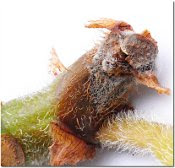 Botrytis now becoming a real problem: witness this mouldy begonia stem. Like the fuchsia earlier, it's been feeding on sugar in sap oozed from wound. Seems to have already entered stem, probably through vascular system, and has begun to break down the plant tissue, causing rot.
Botrytis now becoming a real problem: witness this mouldy begonia stem. Like the fuchsia earlier, it's been feeding on sugar in sap oozed from wound. Seems to have already entered stem, probably through vascular system, and has begun to break down the plant tissue, causing rot. What's worrying about all this? Begonia is still growing. Not yet in storage. But has somewhat reduced vigour from earlier in season, making it easier for the fungus to attack (healthy active plants can fight back against diseases).
What's worrying about all this? Begonia is still growing. Not yet in storage. But has somewhat reduced vigour from earlier in season, making it easier for the fungus to attack (healthy active plants can fight back against diseases).CURRENT TREATMENT
- Cut off infected stem at least an inch into clean growth.
- Blotted wound dry with clean kitchen towel.
- Sprayed wound with 'Systhane Fungus Fighter'.
- Sprayed botrytis spores on old stem with 'Systhane', as well.
 Perhaps yellow sulphur powder might have been more appropriate, since it would keep the wound dry and is effective against most types of fungi. But 'Systhane' (myclobutanil) is systemic and has a chance of entering the stem (sulphur powder is a contact fungicide) to kill any fungus which might have got in there.
Perhaps yellow sulphur powder might have been more appropriate, since it would keep the wound dry and is effective against most types of fungi. But 'Systhane' (myclobutanil) is systemic and has a chance of entering the stem (sulphur powder is a contact fungicide) to kill any fungus which might have got in there.
FUTURE TREATMENTS
- Shall have to start dusting all fresh wounds with sulphur powder.
- Good idea to spray botrytis with liquid fungicide before handling, to prevent spores being shaken into atmosphere. This would both kill them and prevent dispersal (because they will be wet).
- Need to be more vigilant and examine plants every week. All dead plant material should be removed immediately.
After removing foliage, leaving a piece of dusted stem about 10 to 15 cm (4 to 6 inches) attached to tuber is a good idea when storing - allows room for fungus attack to be cut away, if necessary. The stems fall off later, once tubers have prepared themselves. They can then be removed.
No comments:
Post a Comment